Mary Anne Yarde's Blog: The Coffee Pot Book Club , page 187
January 22, 2018
Life in the time of King Alfred By Tracy Ann Miller #AngloSaxon #history @tracyamiller1
Life in the time of King AlfredBy Tracy Ann Miller
In the time of King Alfred, in Anglo-Saxon England, there existed a world I knew would make a rich, exciting backdrop for a romance novel. Vikings and Saxons still battled for control, but peace was in sight. This Saxon/Viking aspect, then, was both a built-in conflict between my hero and heroine, and a plausible possibility.
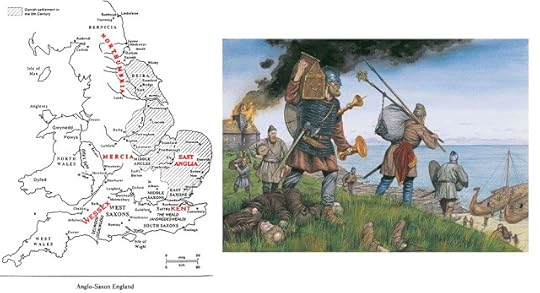
Women were independent. Sort of.
I discovered in my research of the year 877, that married women and widows achieved a higher status, could own and inherit property, engage in legal transactions, and had offences against them penalized heavily. Girls and boys were close to equal in terms of status when it came to inheritances. Though most women were relegated to domestic life, many women came to power as abbesses and leaders of government.

This information gave me enough license to create Amber, my heroine in The Maiden Seer, as a woman who was not beholden to a man for her future prospects. She chose her own path. The same is said of my heroine, Llyrica in Loveweaver.
Learning about Alfred, King of Wessex, also shaped The Maiden Seer.
The events of 877-878 have been told so often that it’s a history lesson simple enough for even me to understand! It tells of how King Alfred escaped the Vikings when they attacked his royal stronghold of Chippenham. With his family and small band he fled to the marshes of Somerset, and from this hidden fort, surreptitiously continued to fight against the Vikings.
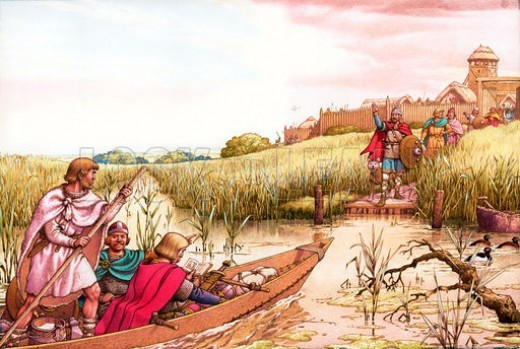
I decided I could let Amber be Alfred’s niece, have her timeline parallel his, and have her influence the outcome of her uncle’s struggles.
Of course, I brought in a Viking. But Konnar is not a Viking who fights against her, but one who becomes an ally. And so much more!
As some Vikings began to settle peacefully, marriages between Vikings and Saxons were becoming common. It would not have been out of the question that Amber and Konnar could end up together and become a part of the local community.
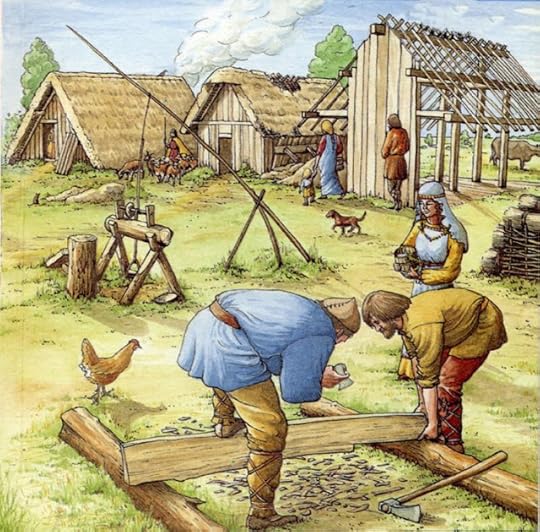
It was the details in the time Anglo-Saxon England, though, that most caught my attention. Or rather *lack* of details.
We have rudimentary drawings from the time, wonderful artifacts, and scant descriptions of where and how people lived, what they wore, and what they ate and drank.
With the known facts as my foundation, I exercised freedom embellishing how things *might* have been, from earthworks and forts, towns and harbours, homes and their interiors, mode of dress and accessories, hair styles, and meals.
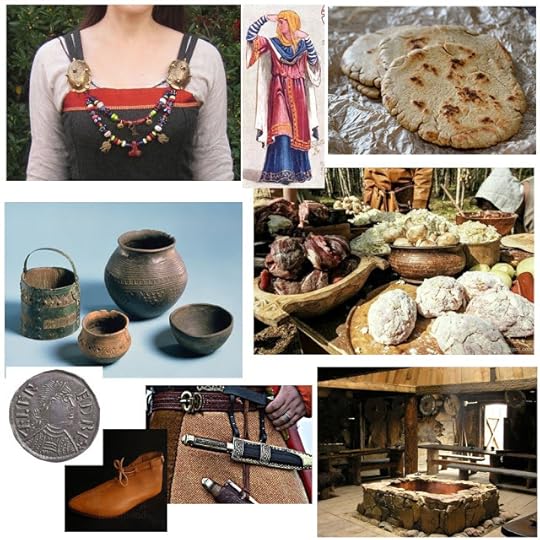
When I learned about the Elder Futhark and runes, I knew the story Amber would tell.
The Elder Futhark originated as an alphabet, a writing system, dating back to perhaps the 1st century. When it took on mystical attributes as runes is debated, but it was this divinatory use that sparked my interest. Amber would know how to “read” runes, and would be her power and defense in the dangerous time of King Alfred.
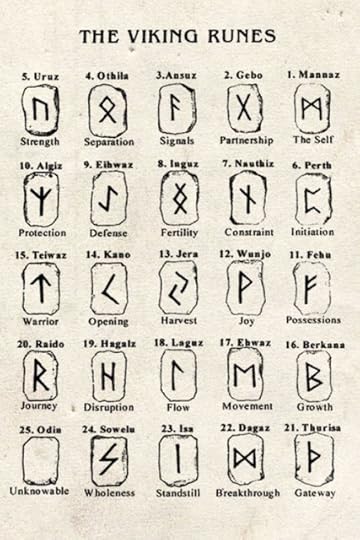
Tracy Ann Miller
 Although Tracy Ann Miller is primarily a graphic designer, (see her work at tracymillerdesigns.com) she has been writing novels for over 20 years.
Although Tracy Ann Miller is primarily a graphic designer, (see her work at tracymillerdesigns.com) she has been writing novels for over 20 years.She was an active member of the National Romance Writers of America with her local chapter, The Virginia Romance Writers. It was there she honed her craft by attending workshops, conferences, and by coordinating The VRW's Fool for Love Contest.
Before being published, she entered and won numerous writing contests, including The Fool for Love Contest for Loveweaver, and the Between the Sheets best love scene contest for The Maiden Seer.
She writes to keep the hero and heroine interacting in story as much as possible (no long separations) and of course they get a spectacular happily ever after.
Tracy invites you to read The Maiden Seer, and her other book, Loveweaver.
tracyannmiller.blogspot.com
The Maiden Seer
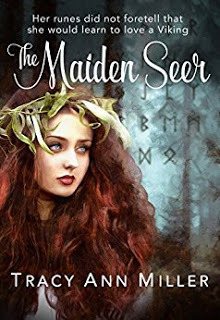 Konnar doesn't believe in the power to tell the future or to see into the unknown. But that changes when Amber comes into his life.
Konnar doesn't believe in the power to tell the future or to see into the unknown. But that changes when Amber comes into his life.Amber, known in her homeland of Wessex, as the Maiden Seer, seeks refuge from her dark foretelling dreams of war. The rune readings she gives to her followers have also become too much to bear. But this can only happen after she fulfills her blackest dream ... one in which she foresees herself killing a man.
Konnar hopes the violent memories of his life as a Viking raider and tragic losses will be quieted when he leaves England forever. This upcoming task will pay for his future and provide for the village that depends on him. But, abducting the Maiden Seer and delivering her to the wealthy client goes wildly awry.
Amber seems to know Konnar's painful secret and claims to foresee a solution. While it enrages him that she negotiates her freedom with this knowledge, should Konnar dare believe the prophetess can help him?
He is her captor, but hiding behind his might and violent history, is a man in need of forgiveness. It is that vulnerable side of him that she learns to love, as she enlists him on her dangerous mission to help the king of England.
The Viking and the Maiden Seer journey throughout England to carry out her prophetic vision. Yet, they struggle with their mutual passion for each other, each unsure of the others true intentions.
But what could it mean, Amber's dark dream that began it all?
Amazon US Amazon UK
<!-- /* Font Definitions */ @font-face {font-family:"Cambria Math"; panose-1:2 4 5 3 5 4 6 3 2 4; mso-font-charset:0; mso-generic-font-family:auto; mso-font-pitch:variable; mso-font-signature:-536870145 1107305727 0 0 415 0;} @font-face {font-family:SimSun; mso-font-alt:宋体; mso-font-charset:134; mso-generic-font-family:auto; mso-font-pitch:variable; mso-font-signature:3 680460288 22 0 262145 0;} /* Style Definitions */ p.MsoNormal, li.MsoNormal, div.MsoNormal {mso-style-unhide:no; mso-style-qformat:yes; mso-style-parent:""; margin:0cm; margin-bottom:.0001pt; mso-pagination:widow-orphan; font-size:12.0pt; font-family:"Times New Roman"; mso-fareast-font-family:SimSun; mso-ansi-language:EN-US; mso-fareast-language:ZH-CN;} .MsoChpDefault {mso-style-type:export-only; mso-default-props:yes; font-size:10.0pt; mso-ansi-font-size:10.0pt; mso-bidi-font-size:10.0pt; mso-fareast-font-family:SimSun;} @page WordSection1 {size:612.0pt 792.0pt; margin:72.0pt 90.0pt 72.0pt 90.0pt; mso-header-margin:36.0pt; mso-footer-margin:36.0pt; mso-paper-source:0;} div.WordSection1 {page:WordSection1;} </style> -->
Published on January 22, 2018 23:00
January 21, 2018
Blog Tour and #Giveaway Where do I go Beverly Magid #HistoricalFiction @hfvbt @BeverlyMagid
Blog Tour and Giveaway ~ Historical Virtual Book Tour Presents....

Where do I go by Beverly Magid
 It’s 1908 and Leah and her boys have immigrated to New York’s Lower East Side to live with her brothers after surviving a pogrom in their Russian village. She is determined to find a home in America but the conditions are harsher than she expected. The garment sweat shops are brutal to work in and it’s essential that her son Benny works after school to help with expenses. Unbeknownst to her he runs errands for the local bookie/gangster. Life isn’t what Leah hoped for, but she’s a fighter and not willing to accept the awful conditions at Wollowitz’s Factory. She’s on a journey to find her own voice, to find a place for herself and her sons, to find a little beauty and romance in her life.
It’s 1908 and Leah and her boys have immigrated to New York’s Lower East Side to live with her brothers after surviving a pogrom in their Russian village. She is determined to find a home in America but the conditions are harsher than she expected. The garment sweat shops are brutal to work in and it’s essential that her son Benny works after school to help with expenses. Unbeknownst to her he runs errands for the local bookie/gangster. Life isn’t what Leah hoped for, but she’s a fighter and not willing to accept the awful conditions at Wollowitz’s Factory. She’s on a journey to find her own voice, to find a place for herself and her sons, to find a little beauty and romance in her life.Excerpt
A few older Jewish women passed her and Leah noticed that they still wore sheitels, wigs, which some had covered with a kerchief. She thought back to the day she and Morris had married. Fanny, the matchmaker, had not been entirely honest with either of them, anxious to close the deal.
“I want a scholarly husband,” Leah had insisted, but even at sixteen, she didn’t want one who was only interested in prayers and Torah. Morris, twelve years older, had requested a smart, strong wife who could give him lots of children, but didn’t expect to marry a rebellious, stubborn girl. When the wedding ceremony was completed and Leah refused to shave her hair in Orthodox Jewish custom, Morris was outraged and even angrier when she refused to give up her secular books, novels by Tolstoy and Dostoyevsky and poetry by Pushkin.
“They are blasphemous,” he yelled, while she shouted back, “I will never give them up, never.”
She made it worse by speaking Russian, a language considered forbidden by the Orthodox community who insisted that Jews only speak Yiddish, not the language of their oppressors. Finally, in a compromise, she agreed to keep her thick braids covered and never speak Russian in public. She would promise nothing more. Leah had always wanted to go her own way, a path her father had encouraged, but strangely not her mother.“If you must disagree, keep your opinions to yourself,” she had counseled, much to Leah’s surprise even at a young age. “Men can be very hard to live with, otherwise. Not everyone is like your father.” Morris certainly was not like him and Leah tried keeping quiet, but most times she couldn’t.As she walked by a storefront, she stopped a moment to see her reflection in the store window. A tallish, young woman appearing a bit older than her twenty-eight years stared back at her, reddish-brown hair, still braided, but uncovered, wearing a long skirt and shirtwaist, looking like any average American woman. If only she could really feel American, feel she was at home.
Giveaway
During the Book Blast we will be giving away a signed copy of WHERE DO I GO! To enter, please enter here.
Giveaway Rules
• Giveaway ends at 11:59pm EST on February 2nd. You must be 18 or older to enter.• Giveaway is open to residents in the US only. – Only one entry per household.• All giveaway entrants agree to be honest and not cheat the systems; any suspect of fraud is decided upon by blog/site owner and the sponsor, and entrants may be disqualified at our discretion.• Winner has 48 hours to claim prize or new winner is chosen.
Beverly Magid
 Beverly Magid, before writing her novel, was a journalist and an entertainment and celebrity PR executive, who interviewed many luminaries, including John Lennon, Jim Croce and the Monty Python gang, and as a publicist represented clients in music, tv and film, ranging from Whoopi Goldberg, John Denver and Dolly Parton to Tom Skerritt, Martin Landau, Kathy Ireland and Jacqueline Bisset.
Beverly Magid, before writing her novel, was a journalist and an entertainment and celebrity PR executive, who interviewed many luminaries, including John Lennon, Jim Croce and the Monty Python gang, and as a publicist represented clients in music, tv and film, ranging from Whoopi Goldberg, John Denver and Dolly Parton to Tom Skerritt, Martin Landau, Kathy Ireland and Jacqueline Bisset.Beverly is a longtime west coast resident who still considers herself a New Yorker. Among the social issues she’s passionate about is literacy and she worked with KorehLA to mentor elementary children in reading. Also she has been an advocate for Jewish World Watch, an organization dedicated to working against genocide and to aid the victims of war atrocities. On a lighter side, she is also a volunteer at the Los Angeles Zoo, monitoring animal behavior for their Research Department.
She is a news and political junkie who supports environmental, animal and human rights issues. She believes most passionately that “We must remain vigilant to the those who would erode the rights of people around the world and work to defeat them.”
For more information, please visit Beverly Magid’s website. You can also find her on Facebook, Twitter, and Goodreads.
Where Do I Go by Beverly MagidPublication Date: October 9, 2017BeWrite PressPaperback & eBook; 138 PagesGenre: Fiction/His
Published on January 21, 2018 23:00
January 18, 2018
In the Time of The Pied Piper of Hamelin By Mary Ann Bernal. #history behind the #fairytale #Germany @BritonandDane
In the Time ofThe Pied Piper of Hamelin
By Mary Ann Bernal
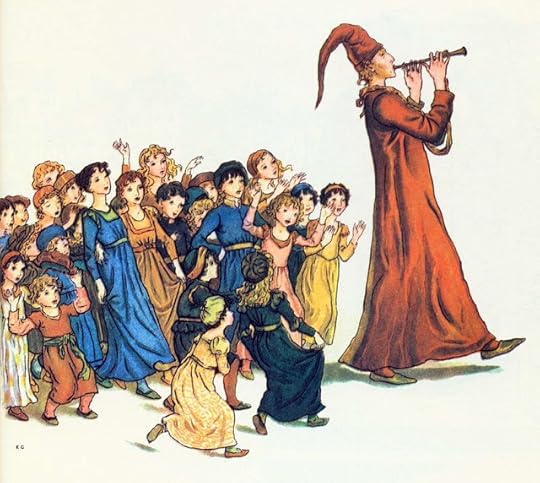
Most people are familiar with the Brothers Grimm tale of the Pied Piper of Hamelin. As the story goes, when the Piper did not receive payment from the town of Hamelin after he had rid them of their rat problem, he absconded with the children who were never seen again.
Was this fairytale that was meant to scare children fact or fiction? As with many fables, there is some truth to the story relating to events occurring in the thirteenth century.

Hamelin (Hameln as it is called in German) is a town on the river Weser, located in the Lower Saxony region of Germany. The settlement arose around the Abbey of St. Boniface that had been founded by the monks of Fulda in the latter part of the eighth century.
Fulda, in central Germany, was a flourishing city built on the Fulda River. During its heyday, it was well-known for its great library, but the school was an important seat of learning, drawing students from afar. A Benedictine Abbey was established towards the end of the eighth century and became a renowned missionary center. A replica of the Old St. Peter’s Basilica in Rome had been built to properly honor the relics of St. Boniface buried within the crypt. Pilgrims journeyed to the church praying for miracles. As time passed, the coffers were overflowing and these funds were used to set up daughter houses such as the Abbey located in Hamelin.
Even though Hamelin was a prosperous corn-trading mill town, the majority of people lived in poverty. Famine and disease plagued the less fortunate who could not feed their children. There was also the constant threat of war with nobles trying to annex more land to their territories. Add an infestation of rats to an already volatile environment caused concern among government officials. The logical thing to do was seek the services of a professional rat catcher.
Enter a piper, who convinced the officials he could rid the place of the vermin with his music for a fee. While skeptical, the bureaucrats agreed, and much to their surprise, the man was successful. However, they refused to pay him. The piper threatened to take all the children if he was not paid for his services. When payment was not received, the piper, true to his word, left the town along with the children.
According to historical accountants, the children of Hamelin did disappear and there have been many theories over the years as to what truly happened.
As in the Hansel and Gretel fairytale, it has been stated that parents had no problem getting rid of their children for a multitude of reasons. It is possible that the Pied Piper story was created to take attention away from the parents’ culpability and place the blame elsewhere.
Rats with their plague-carrying fleas may have caused the children’s demise, but the pestilence had yet to run rampant throughout Europe during the period in question.
Another theory suggested that the children may have run off to join the Children’s Crusade on their own volition. The Crusade was established to free the Holy Land from Muslim occupation. Whether or not children actually reached Jerusalem is up for debate, but reports of bands of poor people, not necessarily lone children, had been seen wandering throughout the region at that time.
Since the legend references the children dancing to the tune of the Pied Piper, suffering from a dancing plague, referred to as St. Vitus ’ dance, has also been suggested. This illness might have been caused by the toxicity of ergot fungi, but again, this is conjecture.
Of interest, is the mention of three disabled children (lame, deaf and blind) that were allegedly left behind.
The finer points vary, depending on which version is followed.
Whatever happened to the children remains a mystery but modern Hamelin continues to keep the legend alive. A major tourist attraction, the town is renowned throughout the world.
On any given Sunday from May through September, re-enactors bring the fairytale to life. If you visit off-season, there is a museum that features an animated film of the story.

The missing children have not been forgotten over the centuries because the legend continues to enthrall its audience.
References Pied Piper ~ Wikipedia Hamelin Town Replica ~ Wikipedia
Piper House ~ Wikipedia
Rat whistle 5”x4 made from clay ~ Courtesy © Elisabeth Marrion Printed with permission.
Mary Ann Bernal
 Mary Ann Bernal, author of The Briton and the Danenovels and the Scribbler Talesseries, is an avid history buff who also enjoys science fiction. She is a passionate supporter of the U.S. military, having been involved with letter writing campaigns and other military support programs since Operation Desert Storm. All of Mary Ann’s novels and short story collections are dedicated to fallen military heroes who gave their lives defending our freedom. A prolific writer originally hailing from New York, Mary Ann now resides in Nebraska.
Mary Ann Bernal, author of The Briton and the Danenovels and the Scribbler Talesseries, is an avid history buff who also enjoys science fiction. She is a passionate supporter of the U.S. military, having been involved with letter writing campaigns and other military support programs since Operation Desert Storm. All of Mary Ann’s novels and short story collections are dedicated to fallen military heroes who gave their lives defending our freedom. A prolific writer originally hailing from New York, Mary Ann now resides in Nebraska.Learn more about the author’s background and interests at maryannbernal.com and whisperinglegendspress.com.

Amazon US Amazon UK Smashwords Barnes & Noble
Published on January 18, 2018 23:00
January 17, 2018
Myths, Legends, Books, Coffee Pots… and a Pirate! By Helen Hollick #HistFic #Pirates @HelenHollick
Please welcome back the fabulous Helen Hollick!
Author’s Inspiration
Myths, Legends, Books, Coffee Pots… and a Pirate!

Pirates. I write about pirates. The real ones (on occasion) and the fictional romantic/heroic ones more often – well regularly actually. I have my very own fictional pirate, you see and I must admit I’m not sure if he is a blessing or a curse!
Jesamiah Acorne (Captain Jesamiah Acorne) came into my life over ten years ago (is that a relationship or a sentence?) soon after I had seen the first Pirates of the Caribbean Movie – The Curse of the Black Pearl. (We won’t talk about the others in the franchise. Frankly, they were not very good.) The Black Pearl was fun. It was not meant to be taken seriously. Originally Disney intended it as a children’s film to boost flagging interest in their Pirate Ride attraction. They reckoned without Johnny Depp and his portrayal of Jack Sparrow, however.
As with nearly every other PoC fan, from the instant we saw that scoundrel drifting into Port Royal standing atop a mast – and we realised that the boat was rapidly sinking – Sparrow’s nonchalance and wit had us hooked. The action, the plot, the dialogue, the drama, the romance: all of it was absorbing. I have lost count of how many times I have watched – and laughed through – that cheer-you-up movie.

There was a snag, however. I like movies but… I prefer novels. Good, exciting page-turning novels where we, the reader, can enter a different make-believe world, where we can picture the hero and heroine, the scenery and the accompanying characters for ourselves. And once smitten with a topic I like to indulge in a binge of reading about it, so I looked for some novels that would match PoTC. I could not find any. There were plenty of Young Adult novels, but I wanted something with some (tasteful) ‘Adult’ spice included. There were dozens of ‘straight’ nautical adventures as well… I devoured Frenchman’s Creek, C.S. Forester’s Hornblower, Patrick O’Brian’s Jack Aubrey… Alexander Kent, Julian Stockwin, James L. Nelson…all exciting novels, but most of them have very limited female character scenes – and not a single dash of fantasy anywhere.
Solution. I decided to write my own.
I researched the period – early 1700s – made copious notes, jotted down ideas. I had my main plot (based on actual events circa 1715-1717) my fantasy element; my Female Lead was to be a White Witch, midwife and healer, she was Tiola Oldstagh, a pretty, gentle soul, whose spirit had been in existence for centuries. I had most of the dastardly ‘baddies’ lined up, an entire crew, and a couple of ships for them to be pirates in, the main star being Sea Witch, based on the replica ship HMS Rose, now more widely known as HMS Surprise. But problem. No protagonist hero had stepped forward to make himself known.
He appeared out of the blue (well grey) one rain-drizzled afternoon while I was on vacation. Strolling along an English south-coast beach I sat on a rock, thinking about the story I was planning to write. I looked up, and there he was. I saw him quite clearly (either for real or in my mind, I’ll leave you to decide.) Dressed in full pirate regalia he had royal-blue ribbons laced into his black hair and a gold acorn-shaped earring dangling from his ear. He nodded, touched his pirate hat in salute.I nodded back, said aloud, “Hello Jesamiah Acorne.”
And that is how we met. He has been the love of my life (and the bane of it!) ever since!
I wrote that first tale, Sea Witch in less than three months expecting it to be a one-off single novel, but once a pirate plunders your heart, mind and keyboard, you are held hostage.

I am about to start writing the Sixth Voyage in the series: Gallows Wake, although I have recently brought out a short novella prequel When The Mermaid Sings, which, technically, comes at the start of the adventures, although I would recommend begining with Sea Witch.

I have also produced a non-fiction book, Pirates: Truth and Tales, which I thoroughly enjoyed writing, (although the publisher messed up for the first edition and printed from an uncorrected proof. Fortunately there were not too many horrid bloopers.)

Until Jesamiah took over my life, heart and soul I wrote plain historical fiction. For my C.V., I have an Arthurian Trilogy (The Pendragon’s Banner Trilogy) set firmly in post-Roman Britain with not a squidgeon of myth or magic in it. No turreted castles, no Lancelot, Merlin or Holy Grail, just a ‘what might have happened’ tale of the boy who became a man, who became a king, who became a legend. Then I wrote my version (the English view, not the Norman propaganda) of the story of events that led to the 1066 Battle of Hastings, and following on, the story of Emma, Queen to King Aethelread and then King Cnut (Canute). This one, under it’s US title The Forever Queen was listed as a USA Today Bestseller.
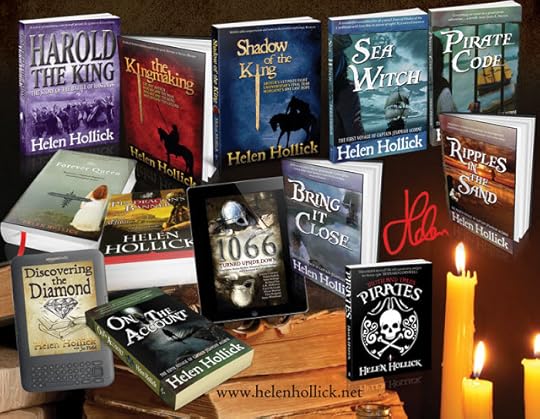
I enjoy writing my pirate adventures, though because I can have fun with them – as with that movie they are meant to be read with a tongue firmly in the cheek. My sailing detail is as accurate as I can get it (I’m no sailor, I have never been in anything other than a North Sea or Isle of Wight ferry.) I do my historical research as thoroughly as I can, although I occasionally mix-and-match the facts a little (but always mention where I’ve spliced a few different things together in my author’s notes.) My intention is to write a series of romping nautical adventure yarns for adults, populated with memorable characters.
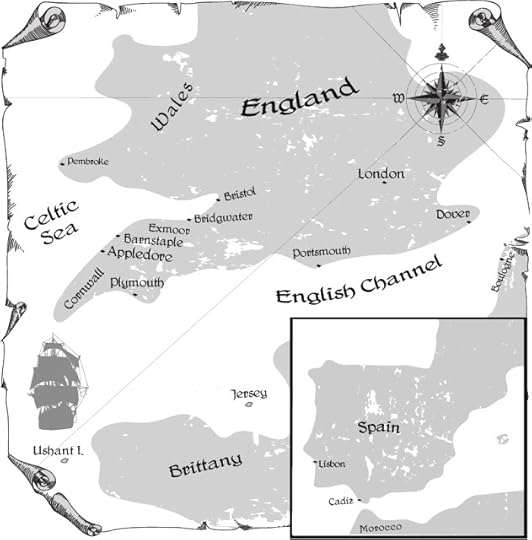
I describe Jesamiah as a blend of Hornblower, Jack Aubrey, Jack Sparrow, Indiana Jones, James Bond and Bernard Cornwell’s Richard Sharp, while my tag line for the series is: “Trouble follows Jesamiah Acorne like a ship’s wake” which is why I am not sure whether Jesamiah is a blessing or a curse. That darn pirate gets himself into trouble at every turn of the tide – then expects me to get him out of it!
About Sea Witch
 The Time : The Golden Age of Piracy - 1716.
The Time : The Golden Age of Piracy - 1716.
The Place : The Pirate Round - from the South African Coast to the sun drenched Islands of the Caribbean.
Escaping the bullying of his elder half brother, from the age of fifteen Jesamiah Acorne has been a pirate with only two loves - his ship and his freedom. But his life is to change when he and his crewmates unsuccessfully attack a merchant ship off the coast of South Africa.
He is to meet Tiola Oldstagh an insignificant girl, or so he assumes - until she rescues him from a vicious attack, and almost certain death, by pirate hunters. And then he discovers what she really is; a healer, a midwife - and a white witch. Her name, an anagram of "all that is good." Tiola and Jesamiah become lovers, but the wealthy Stefan van Overstratten, a Cape Town Dutchman, also wants Tiola as his wife and Jesamiah's jealous brother, Phillipe Mereno, is determined to seek revenge for resentments of the past, a stolen ship and the insult of being cuckolded in his own home.
When the call of the sea and an opportunity to commandeer a beautiful ship - the Sea Witch - is put in Jesamiah's path he must make a choice between his life as a pirate or his love for Tiola. He wants both, but Mereno and van Overstratten want him dead.In trouble, imprisoned in the darkness and stench that is the lowest part of his brother's ship, can Tiola with her gift of Craft, and the aid of his loyal crew, save him?Using all her skills Tiola must conjure up a wind to rescue her lover, but first she must brave the darkness of the ocean depths and confront the supernatural being, Tethys, the Spirit of the Sea, an elemental who will stop at nothing to claim Jesamiah Acorne's soul and bones as a trophy.
Links for PurchaseAmazon US Amazon UK
About Helen Helen Hollick moved from London in 2013 and now lives with her family in North Devon, in an eighteenth century farmhouse surrounded by fields and woodland. A variety of pets include horses, Exmoor ponies, dogs, cats, a donkey, chickens, ducks and geese.First published in 1994, her passion now is her pirate character, Captain Jesamiah Acorne of the nautical adventure series, The Sea Witch Voyages.
Helen Hollick moved from London in 2013 and now lives with her family in North Devon, in an eighteenth century farmhouse surrounded by fields and woodland. A variety of pets include horses, Exmoor ponies, dogs, cats, a donkey, chickens, ducks and geese.First published in 1994, her passion now is her pirate character, Captain Jesamiah Acorne of the nautical adventure series, The Sea Witch Voyages.
Helen became a USA Today Bestseller with her historical novel, The Forever Queen (titled A Hollow Crown in the UK) – the story of Saxon Queen, Emma of Normandy. Her novel Harold the King (titled I Am The Chosen King in the US) explores the events that led to the 1066 Battle of Hastings. While her Pendragon’s Banner Trilogy, set in the fifth century, is widely acclaimed as a more historical version of the Arthurian legend. She has written three non-fiction books, Pirates - Truth and Tales; a book about smuggling (due to be published 2018) and as a supporter of indie writers, co-wrote Discovering the Diamond with her editor, Jo Field,a short advice guide for new writers interested in self-publishing. She also runs the Discovering Diamondsreview blog for historical fiction assisted by a team of wonderfully enthusiastic reviewers.
Helen is published in various languages including Turkish and Italian.
You can find Helen… Amazon Author Page Newsletter Subscription Website Twitter Facebook Blog Discovering Diamonds Historical Fiction Review Blog:
Author’s Inspiration
Myths, Legends, Books, Coffee Pots… and a Pirate!

Pirates. I write about pirates. The real ones (on occasion) and the fictional romantic/heroic ones more often – well regularly actually. I have my very own fictional pirate, you see and I must admit I’m not sure if he is a blessing or a curse!
Jesamiah Acorne (Captain Jesamiah Acorne) came into my life over ten years ago (is that a relationship or a sentence?) soon after I had seen the first Pirates of the Caribbean Movie – The Curse of the Black Pearl. (We won’t talk about the others in the franchise. Frankly, they were not very good.) The Black Pearl was fun. It was not meant to be taken seriously. Originally Disney intended it as a children’s film to boost flagging interest in their Pirate Ride attraction. They reckoned without Johnny Depp and his portrayal of Jack Sparrow, however.
As with nearly every other PoC fan, from the instant we saw that scoundrel drifting into Port Royal standing atop a mast – and we realised that the boat was rapidly sinking – Sparrow’s nonchalance and wit had us hooked. The action, the plot, the dialogue, the drama, the romance: all of it was absorbing. I have lost count of how many times I have watched – and laughed through – that cheer-you-up movie.

There was a snag, however. I like movies but… I prefer novels. Good, exciting page-turning novels where we, the reader, can enter a different make-believe world, where we can picture the hero and heroine, the scenery and the accompanying characters for ourselves. And once smitten with a topic I like to indulge in a binge of reading about it, so I looked for some novels that would match PoTC. I could not find any. There were plenty of Young Adult novels, but I wanted something with some (tasteful) ‘Adult’ spice included. There were dozens of ‘straight’ nautical adventures as well… I devoured Frenchman’s Creek, C.S. Forester’s Hornblower, Patrick O’Brian’s Jack Aubrey… Alexander Kent, Julian Stockwin, James L. Nelson…all exciting novels, but most of them have very limited female character scenes – and not a single dash of fantasy anywhere.
Solution. I decided to write my own.
I researched the period – early 1700s – made copious notes, jotted down ideas. I had my main plot (based on actual events circa 1715-1717) my fantasy element; my Female Lead was to be a White Witch, midwife and healer, she was Tiola Oldstagh, a pretty, gentle soul, whose spirit had been in existence for centuries. I had most of the dastardly ‘baddies’ lined up, an entire crew, and a couple of ships for them to be pirates in, the main star being Sea Witch, based on the replica ship HMS Rose, now more widely known as HMS Surprise. But problem. No protagonist hero had stepped forward to make himself known.
He appeared out of the blue (well grey) one rain-drizzled afternoon while I was on vacation. Strolling along an English south-coast beach I sat on a rock, thinking about the story I was planning to write. I looked up, and there he was. I saw him quite clearly (either for real or in my mind, I’ll leave you to decide.) Dressed in full pirate regalia he had royal-blue ribbons laced into his black hair and a gold acorn-shaped earring dangling from his ear. He nodded, touched his pirate hat in salute.I nodded back, said aloud, “Hello Jesamiah Acorne.”
And that is how we met. He has been the love of my life (and the bane of it!) ever since!
I wrote that first tale, Sea Witch in less than three months expecting it to be a one-off single novel, but once a pirate plunders your heart, mind and keyboard, you are held hostage.

I am about to start writing the Sixth Voyage in the series: Gallows Wake, although I have recently brought out a short novella prequel When The Mermaid Sings, which, technically, comes at the start of the adventures, although I would recommend begining with Sea Witch.

I have also produced a non-fiction book, Pirates: Truth and Tales, which I thoroughly enjoyed writing, (although the publisher messed up for the first edition and printed from an uncorrected proof. Fortunately there were not too many horrid bloopers.)

Until Jesamiah took over my life, heart and soul I wrote plain historical fiction. For my C.V., I have an Arthurian Trilogy (The Pendragon’s Banner Trilogy) set firmly in post-Roman Britain with not a squidgeon of myth or magic in it. No turreted castles, no Lancelot, Merlin or Holy Grail, just a ‘what might have happened’ tale of the boy who became a man, who became a king, who became a legend. Then I wrote my version (the English view, not the Norman propaganda) of the story of events that led to the 1066 Battle of Hastings, and following on, the story of Emma, Queen to King Aethelread and then King Cnut (Canute). This one, under it’s US title The Forever Queen was listed as a USA Today Bestseller.

I enjoy writing my pirate adventures, though because I can have fun with them – as with that movie they are meant to be read with a tongue firmly in the cheek. My sailing detail is as accurate as I can get it (I’m no sailor, I have never been in anything other than a North Sea or Isle of Wight ferry.) I do my historical research as thoroughly as I can, although I occasionally mix-and-match the facts a little (but always mention where I’ve spliced a few different things together in my author’s notes.) My intention is to write a series of romping nautical adventure yarns for adults, populated with memorable characters.

I describe Jesamiah as a blend of Hornblower, Jack Aubrey, Jack Sparrow, Indiana Jones, James Bond and Bernard Cornwell’s Richard Sharp, while my tag line for the series is: “Trouble follows Jesamiah Acorne like a ship’s wake” which is why I am not sure whether Jesamiah is a blessing or a curse. That darn pirate gets himself into trouble at every turn of the tide – then expects me to get him out of it!
About Sea Witch
 The Time : The Golden Age of Piracy - 1716.
The Time : The Golden Age of Piracy - 1716.The Place : The Pirate Round - from the South African Coast to the sun drenched Islands of the Caribbean.
Escaping the bullying of his elder half brother, from the age of fifteen Jesamiah Acorne has been a pirate with only two loves - his ship and his freedom. But his life is to change when he and his crewmates unsuccessfully attack a merchant ship off the coast of South Africa.
He is to meet Tiola Oldstagh an insignificant girl, or so he assumes - until she rescues him from a vicious attack, and almost certain death, by pirate hunters. And then he discovers what she really is; a healer, a midwife - and a white witch. Her name, an anagram of "all that is good." Tiola and Jesamiah become lovers, but the wealthy Stefan van Overstratten, a Cape Town Dutchman, also wants Tiola as his wife and Jesamiah's jealous brother, Phillipe Mereno, is determined to seek revenge for resentments of the past, a stolen ship and the insult of being cuckolded in his own home.
When the call of the sea and an opportunity to commandeer a beautiful ship - the Sea Witch - is put in Jesamiah's path he must make a choice between his life as a pirate or his love for Tiola. He wants both, but Mereno and van Overstratten want him dead.In trouble, imprisoned in the darkness and stench that is the lowest part of his brother's ship, can Tiola with her gift of Craft, and the aid of his loyal crew, save him?Using all her skills Tiola must conjure up a wind to rescue her lover, but first she must brave the darkness of the ocean depths and confront the supernatural being, Tethys, the Spirit of the Sea, an elemental who will stop at nothing to claim Jesamiah Acorne's soul and bones as a trophy.
Links for PurchaseAmazon US Amazon UK
About Helen
 Helen Hollick moved from London in 2013 and now lives with her family in North Devon, in an eighteenth century farmhouse surrounded by fields and woodland. A variety of pets include horses, Exmoor ponies, dogs, cats, a donkey, chickens, ducks and geese.First published in 1994, her passion now is her pirate character, Captain Jesamiah Acorne of the nautical adventure series, The Sea Witch Voyages.
Helen Hollick moved from London in 2013 and now lives with her family in North Devon, in an eighteenth century farmhouse surrounded by fields and woodland. A variety of pets include horses, Exmoor ponies, dogs, cats, a donkey, chickens, ducks and geese.First published in 1994, her passion now is her pirate character, Captain Jesamiah Acorne of the nautical adventure series, The Sea Witch Voyages.Helen became a USA Today Bestseller with her historical novel, The Forever Queen (titled A Hollow Crown in the UK) – the story of Saxon Queen, Emma of Normandy. Her novel Harold the King (titled I Am The Chosen King in the US) explores the events that led to the 1066 Battle of Hastings. While her Pendragon’s Banner Trilogy, set in the fifth century, is widely acclaimed as a more historical version of the Arthurian legend. She has written three non-fiction books, Pirates - Truth and Tales; a book about smuggling (due to be published 2018) and as a supporter of indie writers, co-wrote Discovering the Diamond with her editor, Jo Field,a short advice guide for new writers interested in self-publishing. She also runs the Discovering Diamondsreview blog for historical fiction assisted by a team of wonderfully enthusiastic reviewers.
Helen is published in various languages including Turkish and Italian.
You can find Helen… Amazon Author Page Newsletter Subscription Website Twitter Facebook Blog Discovering Diamonds Historical Fiction Review Blog:
Published on January 17, 2018 23:00
January 16, 2018
Author’s Inspiration ~ Mohanalakshmi Rajakumar #HistFic @moha_doha
Please give a warm Coffee Pot welcome to historical fiction author, Mohanalakshmi Rajakumar. Mohanalakshmi is going to share with us her inspiration behind her latest book…
The Opposite of Hate

During the 1960s and 70s, more bombs were dropped on a landlocked part of Southeast Asia than in any other war - and it wasn't Vietnam. The turbulent history of the Land of a Thousand Elephants, the Kingdom of Laos, is the backdrop for this family saga, told as a historical novel. THE OPPOSITE OF HATE opens a window onto a forgotten corner of Southeast Asia and brings little known history to life through vivid characters and settings which explore the cultural heritage of Lao history.
THE OPPOSITE OF HATE explores the intersections of family, loyalty, and nationalism as Vientiane, the capital of Laos, is being taken over by Communists. The political instability drives Seng, a widowed engineer, to marry his best friend’s teenage daughter, Neela, so they can escape re-education or even worse, death. The unlikely husband and wife cross the Mekong River into Thailand as strangers.
Life in the refugee camp brings surprises along with the grime. As they struggle for survival, romances blossoms into an unplanned pregnancy. Seng and Neela get their wish of immigrating to the United States. Succeeding in suburbia, however, presents another unique set of challenges, ones that are not black and white.
This is a tale of intermingled violence, love and ambition.
Seng and Neela embody the historic cultural struggle of thousands who fled the threats of communism only to face the challenges of democracy.
Author’s Inspiration
Listen to Others, Listen to Yourself
When I first met my husband’s family, I thought we had a shared identity as Asians. I was born in India; his parents in Laos. After we got married, I learned about the complex, and varied history of Laos. Yes, these were two countries on the continent of Asia, yet with very different colonial histories.
The British in India saw an opportunity to gather many different groups into one nation, then mobilize them into service by making them learn English, and sending them around the world as middle managers.
The French in Laos saw untamed natural beauty and decided to set up residence there to manage the rest of their interests in Southeast Asia. The landlocked country became of strategic importance in contemporary history during the Vietnam War.
Time and again when people ask my husband where he is “from” he will say “Laos.”
“Cambodia?” Most Americans will reply.
He is a patient introvert who consistently smiles at this predictable exchange. I have to remind myself I wouldn’t have known any of this if I hadn’t spent time with his extended family of Laotians who left in the ‘70s for Europe, Australia, or America. The story of their family, members fractured by history, is one we see playing out now for families in Syria and Myanmar.
The more things change, the more they stay the same. What makes these stories similar are their universal truths: parents who long for their children, lovers separated by circumstances, youth ruptured by violence.
Stories are all around us; we tell them at the dinner table about what happened at the traffic light on the way home. And if we are lucky enough, we listen as others tell us about moments in their past. The ones that linger, and you can’t get out of your head because you wish it went a different way or you could do it over.
That’s how I became a writer: I heard snippets of other people’s questions – scenarios that lingered with me and for which I wanted answers. We can pass this inquisitiveness on to others by listening, reading, and of course, writing these stories.
Though we might think otherwise, because of the 10thanniversary of the iPhone, and other advances in technology, the oldest form of sharing we know as a species are stories. We haven’t actually improved on what a story does, or its essential elements.
Beginning, middle, end. Protagonist, antagonist, love interest.
Sure now you can read it on a phone or a tablet or listen to it.
The essence of a story – This Happened to Me and Now You Are My Witness – that hasn’t changed from the original chats around cooking fires. That impulse to reach out and connect with someone else is as natural as the sound of our heartbeats. And what we gain by listening – well this is the part that gives me hope through our tumultuous geo-political present.
Reading historical fiction is a form of witness and that’s why the story at the heart of The Opposite of Hate is a tribute to all the people who were harmed in the unofficial war waged in Laos in the 1970s.
Links for purchase
Amazon US Amazon UK
About the author
 Mohanalakshmi Rajakumar is a South Asian American who has lived in Qatar since 2005. Moving to the Arabian Desert was fortuitous in many ways since this is where she met her husband, had two sons, and became a writer. Her coming of age novel, An Unlikely Goddess, won the SheWrites New Novelist competition in 2011.Her recent books have focused on various aspects of life in Qatar. From Dunes to Dior, named as a Best Indie book in 2013, is a collection of essays related to her experiences as a female South Asian American living in the Arabian Gulf. Love Comes Later was the winner of the Best Indie Book Award for Romance in 2013 and is a literary romance set in Qatar and London. The Dohmestics is an inside look into compound life, the day-to-day dynamics between housemaids and their employers. After she joined the e-book revolution, Mohana dreams in plotlines. Learn more about her work on her website at www.mohadoha.com or follow her latest on Twitter: @moha_doha.<!-- /* Font Definitions */ @font-face {font-family:"MS 明朝"; mso-font-charset:78; mso-generic-font-family:auto; mso-font-pitch:variable; mso-font-signature:-536870145 1791491579 18 0 131231 0;} @font-face {font-family:"Cambria Math"; panose-1:2 4 5 3 5 4 6 3 2 4; mso-font-charset:0; mso-generic-font-family:auto; mso-font-pitch:variable; mso-font-signature:-536870145 1107305727 0 0 415 0;} @font-face {font-family:Cambria; panose-1:2 4 5 3 5 4 6 3 2 4; mso-font-charset:0; mso-generic-font-family:auto; mso-font-pitch:variable; mso-font-signature:-536870145 1073743103 0 0 415 0;} /* Style Definitions */ p.MsoNormal, li.MsoNormal, div.MsoNormal {mso-style-unhide:no; mso-style-qformat:yes; mso-style-parent:""; margin:0cm; margin-bottom:.0001pt; mso-pagination:widow-orphan; font-size:12.0pt; font-family:Cambria; mso-ascii-font-family:Cambria; mso-ascii-theme-font:minor-latin; mso-fareast-font-family:"MS 明朝"; mso-fareast-theme-font:minor-fareast; mso-hansi-font-family:Cambria; mso-hansi-theme-font:minor-latin; mso-bidi-font-family:"Times New Roman"; mso-bidi-theme-font:minor-bidi;} .MsoChpDefault {mso-style-type:export-only; mso-default-props:yes; font-family:Cambria; mso-ascii-font-family:Cambria; mso-ascii-theme-font:minor-latin; mso-fareast-font-family:"MS 明朝"; mso-fareast-theme-font:minor-fareast; mso-hansi-font-family:Cambria; mso-hansi-theme-font:minor-latin; mso-bidi-font-family:"Times New Roman"; mso-bidi-theme-font:minor-bidi;} @page WordSection1 {size:612.0pt 792.0pt; margin:72.0pt 90.0pt 72.0pt 90.0pt; mso-header-margin:36.0pt; mso-footer-margin:36.0pt; mso-paper-source:0;} div.WordSection1 {page:WordSection1;} </style> -->
Mohanalakshmi Rajakumar is a South Asian American who has lived in Qatar since 2005. Moving to the Arabian Desert was fortuitous in many ways since this is where she met her husband, had two sons, and became a writer. Her coming of age novel, An Unlikely Goddess, won the SheWrites New Novelist competition in 2011.Her recent books have focused on various aspects of life in Qatar. From Dunes to Dior, named as a Best Indie book in 2013, is a collection of essays related to her experiences as a female South Asian American living in the Arabian Gulf. Love Comes Later was the winner of the Best Indie Book Award for Romance in 2013 and is a literary romance set in Qatar and London. The Dohmestics is an inside look into compound life, the day-to-day dynamics between housemaids and their employers. After she joined the e-book revolution, Mohana dreams in plotlines. Learn more about her work on her website at www.mohadoha.com or follow her latest on Twitter: @moha_doha.<!-- /* Font Definitions */ @font-face {font-family:"MS 明朝"; mso-font-charset:78; mso-generic-font-family:auto; mso-font-pitch:variable; mso-font-signature:-536870145 1791491579 18 0 131231 0;} @font-face {font-family:"Cambria Math"; panose-1:2 4 5 3 5 4 6 3 2 4; mso-font-charset:0; mso-generic-font-family:auto; mso-font-pitch:variable; mso-font-signature:-536870145 1107305727 0 0 415 0;} @font-face {font-family:Cambria; panose-1:2 4 5 3 5 4 6 3 2 4; mso-font-charset:0; mso-generic-font-family:auto; mso-font-pitch:variable; mso-font-signature:-536870145 1073743103 0 0 415 0;} /* Style Definitions */ p.MsoNormal, li.MsoNormal, div.MsoNormal {mso-style-unhide:no; mso-style-qformat:yes; mso-style-parent:""; margin:0cm; margin-bottom:.0001pt; mso-pagination:widow-orphan; font-size:12.0pt; font-family:Cambria; mso-ascii-font-family:Cambria; mso-ascii-theme-font:minor-latin; mso-fareast-font-family:"MS 明朝"; mso-fareast-theme-font:minor-fareast; mso-hansi-font-family:Cambria; mso-hansi-theme-font:minor-latin; mso-bidi-font-family:"Times New Roman"; mso-bidi-theme-font:minor-bidi;} .MsoChpDefault {mso-style-type:export-only; mso-default-props:yes; font-family:Cambria; mso-ascii-font-family:Cambria; mso-ascii-theme-font:minor-latin; mso-fareast-font-family:"MS 明朝"; mso-fareast-theme-font:minor-fareast; mso-hansi-font-family:Cambria; mso-hansi-theme-font:minor-latin; mso-bidi-font-family:"Times New Roman"; mso-bidi-theme-font:minor-bidi;} @page WordSection1 {size:612.0pt 792.0pt; margin:72.0pt 90.0pt 72.0pt 90.0pt; mso-header-margin:36.0pt; mso-footer-margin:36.0pt; mso-paper-source:0;} div.WordSection1 {page:WordSection1;} </style> -->
Published on January 16, 2018 23:00
January 15, 2018
Scandinavia in the Time of Hakon “the Good” By Eric Schumacher #History #Vikings @DarkAgeScribe
Scandinavia in the Time of Hakon “the Good”By Eric Schumacher

When we think of the Viking Age, we often think of events that happened beyond the borders of Scandinavia, such as the raid on Lindisfarne in 793, the invasion of England by the Great Heathen Army in 865, the attacks on Paris, the discovery of America, and so forth.
One hears far less about life on the homefront, in the geographical areas that are now Norway, Denmark and Sweden. As this is the backdrop of my Hakon Saga novels, I thought I would take you back to the North in the time of the Viking raids, highlight some of major themes of that day, and perhaps dispel some misconceptions.
Countrymen They Were Not
When I first began studying the Vikings, I thought of them as raiders from three distinct countries; but that wasn’t the case at all. For much of the Viking Age, the geographic areas we now call Norway, Denmark, and Sweden were actually a conglomeration of petty kingdoms. Norway was not a unified kingdom with one king until 872, though some might argue it took another thirty to forty years for the land to truly come together under King Hakon “the Good”, the protagonist of my novels. Denmark’s first sole king was Harald Bluetooth, who came to power in c. 958, and who didn’t really subjugate all of the Danish lands until later in his reign. Sweden did not have an undisputed king until c. 970. But even with those monarchs, most people still thought of themselves as hailing from a particular area, not a country; and if they swore allegiance to anyone, it was most likely to their local chieftain or earl, not their king.
Internal Wars
Mention of the Viking Age often conjures images of warriors attacking other kingdoms in their dragon ships. This they did, but that does not mean the homefront lacked for strife. For centuries, the petty kingdoms of Norway, Denmark and Sweden fought each other. From c 850 to 870, King Harald Fairhair fought the kings of Norway’s petty kingdoms for total control of the realm. The same goes for Harald Bluetooth in Denmark in c 970-990, and Eric the Victorious in Sweden in the later half of the 900s. Moreover, the Danes war off an on with the Franks and Norse. The Norse people war with the Swedes and Danes, and so on. The constant strife may be one reason why the Vikings look elsewhere for land. It is certainly one reason why the Vikings are such vicious fighters.
Politically Savage and Savvy
In comparison to continental Europe’s proximity to England, it is easy to think of much of Scandinavia as remote, and therefore, disconnected from the politics and affairs of other European countries. The opposite seems to be true. Scandinavians were very aware of other realms and world events. The Danes of Jutland had an ongoing dispute with the Franks and Saxons. There is documented proof that traders sailed from Wessex in England all the way to the far reaches of what was then called the North Way. Men from Swedish areas traveled east and down through the rivers of modern day Russia and Ukraine to Constantinople. Tales of their exploits and of events in different lands most certainly traveled. The information that made it back to Scandinavia was one of the reasons why the Vikings were so successful in their raids. They knew what was happening in different kingdoms and how best to exploit situations for their advantage.
Staunch Believers
In comparison to the rest of Europe, the Scandinavians were slow to accept Christianity. For the first half of the Viking Age, Christianity did not take hold there, despite the work of missionaries (mostly notably Ansgar) in Denmark, Sweden, and Norway. While Norway saw the first Christian king with Hakon the Good, the missionaries who came to help him convert the land were killed. When Norway finally accepted Christianity in c. 1000 AD, it did so grudgingly, and often through the use of force. Denmark’s monarch Harald converted in c. 970, though it took much longer for the people to convert, nor did the king’s conversion do anything to stem the tide of Danish raids on Christian lands. In fact, the Danish raids on England grew to all-out invasions under the Christian kings of Denmark. While Sweden’s monarch also converted to Christianity in the late 10th century, he converted back to the old gods later on; and it would take another century or so for the Swedes to “defeat” the old gods.
I hope that this gives you a broad picture of Scandinavia during the Viking Age. As in the rest of Europe, it is tumultuous time. The Scandinavians at home were no less susceptible to violence or danger than peoples of the lands they attacked. It is just not something we think about when we think of the Vikings.
Eric Schumacher
 Eric Schumacher (1968 - ) is an American historical novelist who currently resides in Santa Barbara, California, with his wife and two children. He was born and raised in Los Angeles and attended college at the University of San Diego.
Eric Schumacher (1968 - ) is an American historical novelist who currently resides in Santa Barbara, California, with his wife and two children. He was born and raised in Los Angeles and attended college at the University of San Diego. At a very early age, Schumacher discovered his love for writing and medieval European history, as well as authors like J.R.R. Tolkien and C.S. Lewis. Those discoveries continue to fuel his imagination and influence the stories he tells. His first novel, God's Hammer, was published in 2005. Its sequel, Raven’s Feast, was published 2017. A third, yet-to-titled book, is currently in the works.
For more information, connect with him at one of these sites:Website Twitter Facebook
God’s Hammer
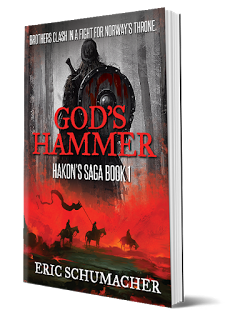 History and legend combine in the gripping tale of Hakon Haraldsson, a Christian boy who once fought for the High Seat of a Viking realm.
History and legend combine in the gripping tale of Hakon Haraldsson, a Christian boy who once fought for the High Seat of a Viking realm.It is 935 A.D. and the North is in turmoil. King Harald Fairhair has died, leaving the High Seat of the realm to his murderous son, Erik Bloodaxe. To solidify his claim, Erik ruthlessly disposes of all claimants to his throne, save one: his youngest brother Hakon.
Erik's surviving enemies send a ship to Wessex, where the Christian King Athelstan is raising Hakon. Unable to avoid his fate, he returns to the Viking North to face his brother and claim his birthright, only to discover that victory will demand sacrifices beyond his wildest nightmares.
US Amazon UK Amazon
Raven’s Feast
It is 935 A.D. and Hakon Haraldsson has just wrested the High Seat of the North from
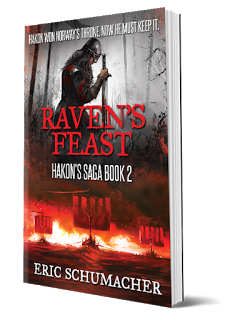 his ruthless brother, Erik Bloodaxe. Now, he must fight to keep it.
his ruthless brother, Erik Bloodaxe. Now, he must fight to keep it.The land-hungry Danes are pressing from the south to test Hakon before he can solidify his rule. In the east, the Uplanders are making their own plans to seize the throne. It does not help that Hakon is committed to his dream of Christianizing his people - a dream his countrymen do not share and will fight to resist.
As his enemies move in and his realm begins to crumble, Hakon and his band of oath-sworn warriors must make a stand in Raven’s Feast, the riveting sequel to God’s Hammer.
US Amazon UK Amazon
Published on January 15, 2018 23:00
January 12, 2018
King Arthur ~ Who was he? #Arthurian #myths #legends
King Arthur ~ Who was he?
“Pay heed to the tales of old wives. It may well be that they alone keep in memory what it was once needful for the wise to know.”J.J.R Tolkien, Lord of the Rings.

Imagine you have been mysteriously transported to Tolkien’s Middle-earth. What do you see? Hobbits, elves, dwarfs… a ring? Rolling valleys, a tiny borough, huge impossible mountains, an all-seeing eye? Whatever you see it is foreign to what you know. It is an imagined kingdom, sweet in the telling, but it has no substance. It is a world apart. So impossibly brilliant that it could never be true.

But I know of a place that has rolling valleys, tiny boroughs and huge impossible mountains. A place where the rivers hide secrets and caves do not give up their treasures. There is no Gondor, but there is a Camelot. There is no Aragorn, but there is an Arthur. There is no Gandalf, but there is a Merlin.
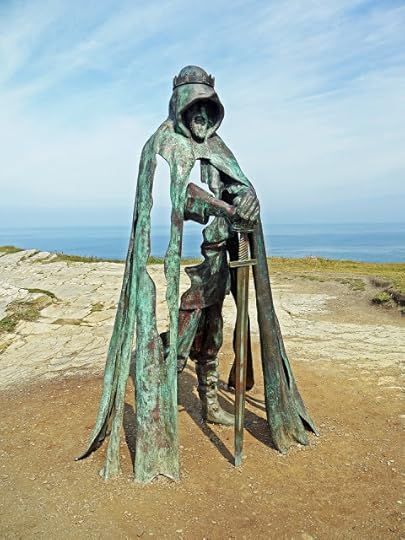
There is no ring, but there is a grail. There is no Middle-earth…
Or is there?
Did Tolkien know something that we did not? You see the island of Britain has an inner story. A story you will not find in a history book. And yet, this story is so compelling that for over a thousand years we have been telling it in one form or another.

This story has sparked pilgrimages. It has encouraged fearful soldiers to be brave. And it has convinced a nation that she will never fall to an aggressor. It is, of course, the story of Arthur and his Knights.
In folklore, we find Arthur, not in some dusty old history book. It is at the hearth where his name was first heard, spoken in whispered tones of awe and then later as someone to imitate. Now we read his story in books or watch it on the big screen. Arthur is everything that is good. A worthy hero. The perfect Knight. A just King. But who was he really?

It is a simple question, but one that is so difficult to answer. Could he be a shadowy Celtic deity? Or perhaps a Roman general? Maybe he is not one man, but several — for there have been many possible Arthur's. Perhaps he is nothing but an invention of a bard's overactive imagination? Is there any truth to him at all?
Over the next couple of posts, I am going to be exploring the possible Arthur's and the land in which he ruled over...
In the meantime ~ why not head over to the 6th Century and find out what happened after the death of King Arthur.
War is coming...

Read for FREE with

Amazon US Amazon UK
Published on January 12, 2018 23:00
January 11, 2018
In the time of King Arthur... Gawain and the Green Knight #Arthurian #Legends #Myths
In the time of King Arthur…
Gawain and the Green Knight

Gustave Doré's illustration of Camelot from Idylls of the King 1867 ~ Wikipedia
In the 14th Century, a poet — whose name has been lost over time, but is now referred to as The Pearl Poet — wrote an epic Arthurian poem. This is how The Pearl Poet described Christmas at Camelot.
“…then they brought the first course, with the blast of trumpets and the waving of banners, with the sound of drums and pipes, so that many a heart was uplifted at the melody. Costly and most delicious foods were carried in. Many were the dainties, delicacies and fresh meats, so great was the plenty they might scarce find room on the board and table-cloth to set all the silver dishes. Each helped himself as he liked best, and for each of two guests were twelve dishes served, with a great plenty of beer and bright wine…”
According to The Pearl Poet, Arthur knew how to throw a party! One would expect a feast at the Midwinter/ New Year celebrations, but perhaps not on such a grand scale.
There would have been music and entertainment at such a feast. I should imagine there were jugglers and those with what we would call Circus Skills!
 Tom 1068 ~ No attribution required ~ Pixabay
Tom 1068 ~ No attribution required ~ PixabayBards would tell wonderful stories to entertain the guests — perhaps they told stories of Arthur and his Knights — and as the evening wore on, old men would become philosophical, as they contemplated mortality.
But there is one story about a Christmas feast that every Arthurian enthusiasts will of heard of, and that is...
Gawain and the Green Knight.by The Pearl Poet
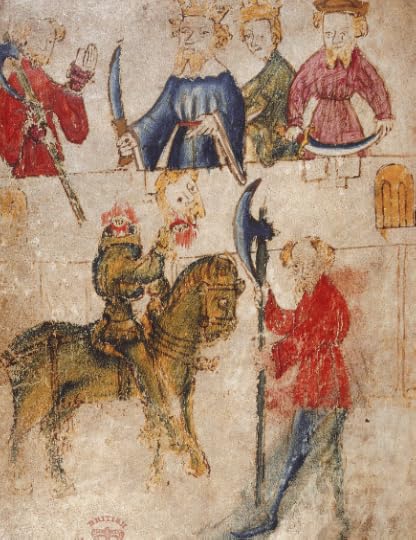 Sir Gawain and the Green Knight (from original manuscript, artist unknown) ~ Wikipedia
Sir Gawain and the Green Knight (from original manuscript, artist unknown) ~ WikipediaIf you not familiar with the story, then read on for a very abridged version with a little of my own poetic licence thrown into the mix!
New Year's Day, Camelot
The Knights of Camelot were celebrating the New Year in Arthur's Great Hall. Food was a plenty, and the mead was freely flowing. Friends and family gathered around the fire pit to listen as a bard wove the most fantastical tale.
Sir Gawain was content to sit and listen to the bard. There was nothing that needed his attention. This was a time to relax and rejoice. The New Year promised to be a good one. The Kingdom was at peace, for the most part, and everything was as it should be.
But this tranquillity was soon quashed when someone pounded against the great oak door of the Hall. The door rattled on its hinges. The bard fell silent, as did everyone else. All eyes turned towards the door and everyone held their breath.
The door opened and there, on a horse the colour of spring grass, was a giant of a man. The giant's skin, like that of his horse, was an unnatural shade of green. Without a by-or-leave, the giant rode his horse into the Hall and dismounted. In his hand was a monster of an axe. This Green Knight narrowed his eyes and looked around him with a contemptuous sneer.
"Is this Arthur's court?" the giant asked, his voice was so loud that some of the women shrieked. "Are these his Knights?"
"It is," Arthur said, rising to his feet. "They are. What can we do for you?"
The Green Knight smiled, showing a perfect set of green teeth. "Your knights are the bravest in the land, or so I am told, and the most chivalrous. Well, we will see about that. I wonder if there is any knight amongst you that would be brave enough to accept a challenge from me."
All the Knights looked to Arthur… But one.
"I will accept your challenge," Sir Gawain said, rising from his seat.
"Gawain, no,” Arthur ordered under his breath.
"Brave boy," the Green Knight snarled. "Or a foolish one. Take my axe, Sir Knight, and chop off my head."
"Why? Do you not like life?" Gawain asked, taking the axe from the Green Knight. The axe was so heavy that Gawain had a job to lift it.
"I do not fear for my life, but perhaps you should fear for yours."
A block was brought forth, and the Green Knight knelt.
"Aim true," he stated.
Shaking his head, Gawain lifted the axe and then with a sickening thud, he took the head from the Green Knight’s shoulders.
The silence that followed was deafening. But then something strange happened. The Green Knight’s headless body stood, and his hands reached for his severed head.
"Meet me at the Chapel Green this time next year, so that I can return the favour," the decapitated head said, and then he left.
Gawain watched as the door closed behind the Green Knight. He turned to face his King with a look of horror. What had he done? There was no way he could survive such a strike.
The year that passed was uneventful, but each day Gawain knew he was a step closer to his death. As the leaves turned from green to brown and the first snow began to fall. Gawain tacked up his horse and, with a heavy heart, he set out for the Chapel Green.
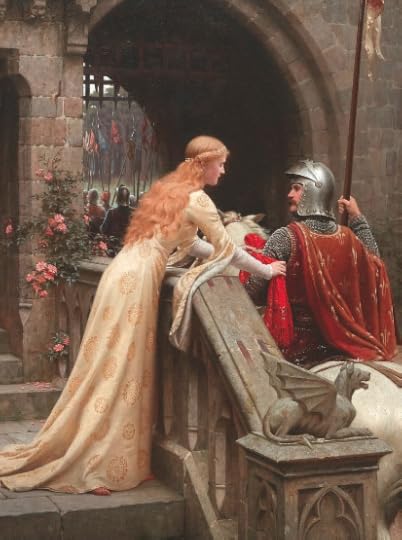 God's Speed by Edmund Blair Leighton 1900 ~ Wikipeida
God's Speed by Edmund Blair Leighton 1900 ~ WikipeidaAfter many weeks of traveling he happened upon a castle, and there he was greeted by Bertilak de Hautdesert and his beautiful wife. Berilak asked Gawain why he was here and Gawain told him only that he had promised to meet someone at the Chapel Green on New Year's Day. Bertilak assured him that the Chapel was just two miles away. Bertilak then, very kindly, invited him to stay with them. Gawain thanked Bertilak and took him up on his generous offer.
The next day Bertilak went hunting. But before he departed he told Gawain that he was more than welcome to stay as long as whatever he might gain during the day, he gave back.
Gawain frowned at such a riddle, but later in the day, all became clear. Bertilak's beautiful wife began to tease him. Gawain had never met anyone like her. She was intoxicating. So very beautiful. Gawain found himself clenching his fists to stop himself from reaching for her. One kiss, he finally allowed, when he could not take it anymore. Just one kiss. I will take nothing more, for Bertilak is my host.
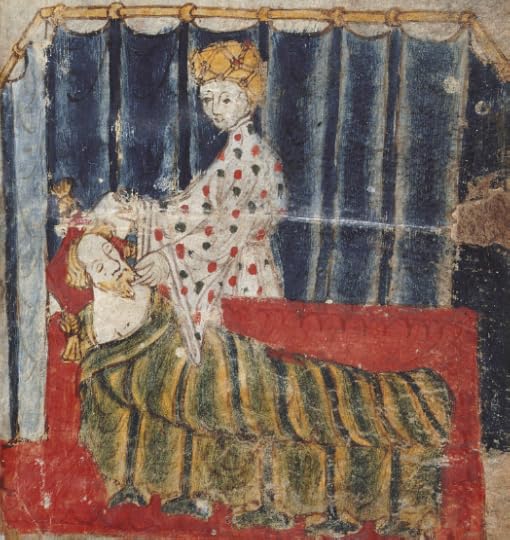 Lady Bertilak at Gawain's bed ~ from original manuscript, artist unknown ~ Wikipedia
Lady Bertilak at Gawain's bed ~ from original manuscript, artist unknown ~ WikipediaWhen Bertilak came back cold and muddy from his hunt, he asked Gawain if he had gained anything this day and if so, he must remember to give it back. So Gawain kissed his host. Sir Bertilak looked confused by the kiss, but he did not comment upon it.
The next day, Bertilak went hunting again. And once again Bertilak's wife began to tease. This time, Gawain allowed two kisses and just like the night before, when Bertilak returns he gave back what he had gained.
On the third day, like the previous days, Bertilak went hunting. This time Bertilak's wife gave Gawain a girdle of green and gold silk. She told him that if he wears it, he would stay safe from harm. They then shared three kisses. That evening he gives Bertilak the three kisses, but keeps the girdle for himself.
 The Lady of Shalott by John William Waterhouse,1880 ~ note the girdle around her waist ~ Wikipedia
The Lady of Shalott by John William Waterhouse,1880 ~ note the girdle around her waist ~ WikipediaThe following day Gawain, with a pounding heart and the girdle wrapped around his waist, set out to meet the Green Knight. He found the giant sharpening his blade outside of the Chapel.
"So you have come?" The Green Knight stated with a look of surprise.
"I accepted the challenge," Gawain stated with a bravery he was not feeling.
"The kneel and place your neck upon the blog, young Knight of Camelot."
Gawain closed his eyes briefly and prayed to God for courage. He knelt and bared his neck. The Green Knight raised his axe. And despite himself, Gawain flinched in fear.
"I should have known," The Green Knight jeered. "You are a coward, and you bring shame to your King."
"Swing again," Gawain growled, "And I will not flinch."
The Green Knight raised his axe and feigned a strike.
"Be done with it," Gawain ordered. "Do not tease."
"I was merely testing your resolve," the Green Knight stated.
The Green Knights raised his axe again, and Gawain closed his eyes. The blade cut through the air, but instead of taking his head it only scratched his skin, although it drew blood.
"That was for the lie you told me, for you are wearing my wife's girdle. Rise, Sir Knight," the Giant stated. "The challenge is over."
With unsteady legs, Gawain rose to his feet and turned to look at the Giant, but the Giant was not there. In his place was his kind host, Bertilak.
"What is this?" Gawain asked, thoroughly confused.
"A test, young knight, from Arthur's sister. She thought you would fail. I am pleased to say you passed, for you are indeed chivalrous, brave, and for the most part... Honest."
Sir Gawain and Sir Bertilak parted on good terms. When Gawain finally made it home from Camelot, he was greeted with a hero's welcome. And from that day on the Knights of Camelot wore a green sash around their waist in recognition of Gawain's quest and a reminded to always be honest.
Copyright © 2017 Mary Anne Yarde
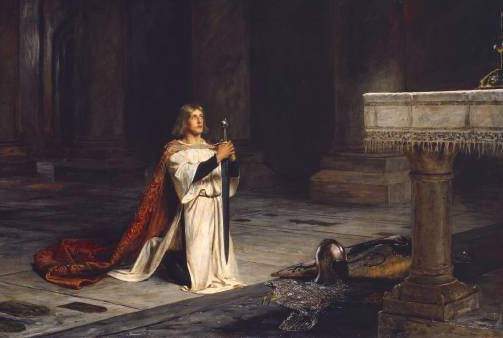 The Vigil by John Pettie, 1888 ~ Gawain represented the perfect knight, as a fighter, a lover, and a religious devotee ~ Wikipedia
The Vigil by John Pettie, 1888 ~ Gawain represented the perfect knight, as a fighter, a lover, and a religious devotee ~ WikipediaIt beats a game of Cluedo and Guess Who? I suppose. Although, I think I will celebrate Christmas and see in the New Year with a couple of board games and a verse of Auld Lang Syne.
War is coming to Saxon Briton…
Read the multi award-winning series for FREE with
Kindle Unlimited

Amazon US Amazon UK

Published on January 11, 2018 23:00
January 10, 2018
The Legend of the Lost Jacobite Treasure, by Amy Rose Bennett #History #Jacobite #Scotland @AmyRoseBennett
The Legend of the Lost Jacobite Treasure By Amy Rose Bennett

I have a new Scottish historical romance release in March, The Laird of Blackloch, and it features the legend of a missing treasure—a fortune in gold coins buried somewhere in the Highlands of Scotland ...
After the Battle of Culloden in which Bonnie Prince Charlie’s rebellion was resoundingly crushed by the British, my Jacobite hero-on-the-run Alexander MacIvor, returns home to Blackloch Castle only to discover Malcolm Campbell, the Earl of Tay—who is loyal to the Crown and the head of a rival clan—has ordered his men to lay waste to his estate. Alex’s family and his affianced have been murdered and Blackloch—situated on the shores of Loch Rannoch in Perthshire—is set alight. Alexander escapes by the skin of his teeth and of course vows bloody vengeance on Tay. But he has no idea how to make that happen ... until after hiding out in the Highland wilderness for several months, injured and his spirit all but broken, he accidentally stumbles across Jacobite clansmen burying caskets of gold coins on the shores of Loch Arkaig. With an untold fortune in his possession—Alex cannot resist the temptation of helping himself to the contents of one of the caskets—he now has the means to reinvent himself and thence execute a campaign to slowly destroy his enemy. Thus begins the tale of The Laird of Blackloch.
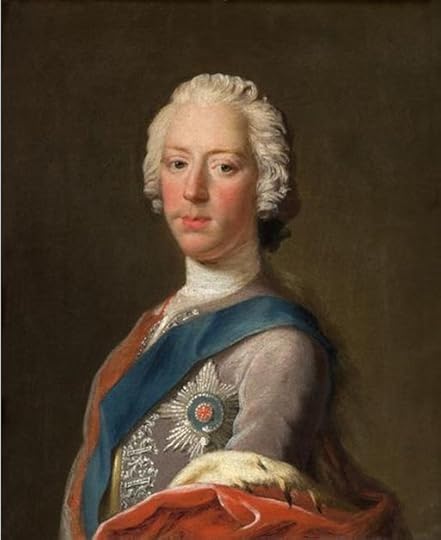 Bonnie Prince Charlie
Bonnie Prince Charlie Legend has it there is a Jacobite treasure hidden somewhere in the Highlands. By all accounts two French frigates, the Bellona and Mars, arrived at Loch nan Uamh on the west coast of Scotland at the end of April 1746 and delivered seven large caskets of gold—worth over one million livres—to support Bonnie Prince Charlie’s cause. However, the Jacobite army had already been defeated at Culloden on 16th April. Apparently the Prince’s former secretary, Murray of Broughton, was entrusted with looking after the treasure; the money was to be used to help fugitive Jacobites. However he was arrested by government troops in June 1746 and the treasure may have been passed to the Camerons of Lochiel for safekeeping. It was reportedly buried on the shores of Loch Arkaig in Lochaber but may have been unearthed and reburied several times over the next few months to prevent loyalist soldiers discovering it. There are also rumours one of the caskets was stolen by the Macdonalds of Barrisdale.
As the story goes, the fugitive Jacobite Ewan ‘Cluny’ Macpherson, the chief of Clan Chattan, was then tasked with looking after and disseminating the gold to Jacobites in need of funds. It’s believed Cluny Macpherson hid himself and perhaps the treasure in a remote mountain cave dubbed ‘Cluny’s Cage’ on the slopes of Ben Alder for nine years. Cluny’s hideout is featured in Robert Louis Stevenson’s classic novel ‘Kidnapped’.
In 1753 Bonnie Prince Charlie—who was living in exile on the Continent—sent the younger brother of the Chief of Cameron of Lochiel, Dr. Archibald Cameron back to the Highlands to locate the gold. However Dr. Cameron was captured by the British and executed for his role in the Forty-Five. The only other account about the gold seems to come from the mid nineteenth century; a small bag of French and Spanish gold coins was supposedly discovered near Loch Arkaig but it certainly wasn’t an immense treasure!
 Loch Arkaig
Loch ArkaigOver the years, many have searched for the missing Jacobite gold, but to this day its whereabouts remains an unsolved mystery. I hope readers enjoy The Laird of Blackloch and my little twist to the legend.
Amy Rose Bennett
 Amy Rose Bennett has always wanted to be a writer for as long as she can remember. An avid reader with a particular love for historical romance, it seemed only natural to write stories in her favorite genre. She has a passion for creating emotion-packed—and sometimes a little racy—stories set in the Georgian and Regency periods. Of course, her strong-willed heroines and rakish heroes always find their happily ever after.
Amy Rose Bennett has always wanted to be a writer for as long as she can remember. An avid reader with a particular love for historical romance, it seemed only natural to write stories in her favorite genre. She has a passion for creating emotion-packed—and sometimes a little racy—stories set in the Georgian and Regency periods. Of course, her strong-willed heroines and rakish heroes always find their happily ever after.Connect with Amy Rose Bennett
Website, Blog ,& Newsletter Facebook Twitter Pinterest Amazon Author Page
The Laird of Blackloch
 Following the Battle of Culloden, Alexander MacIvor returns to his ancestral home, Blackloch Castle, only to find the Earl of Tay, chief of the rival Clan Campbell, has laid waste to everything he holds dear. In the face of such devastation, Alex seems doomed to live the life of a fugitive Jacobite ... until a stroke of good luck allows him to escape the Highlands and begin again.
Following the Battle of Culloden, Alexander MacIvor returns to his ancestral home, Blackloch Castle, only to find the Earl of Tay, chief of the rival Clan Campbell, has laid waste to everything he holds dear. In the face of such devastation, Alex seems doomed to live the life of a fugitive Jacobite ... until a stroke of good luck allows him to escape the Highlands and begin again.Years later, styling himself as a wealthy Englishman, Alexander reclaims his forfeited estate, becoming the new Laird of Blackloch. But it’s not nearly enough to quench his thirst for vengeance. Hell-bent on destroying Lord Tay, he single-mindedly sets about driving his nemesis to bankruptcy. When he learns the earl intends to marry the very beautiful English heiress, Miss Sarah Lambert, thus escaping penury, he devises a devious plan: kidnap Miss Lambert and ransom her to hasten Tay’s ruin.
When Sarah Lambert learns Lord Tay is not the man she thought he was during a masquerade ball in Edinburgh, she is devastated. Reeling from her discovery, things go from bad to worse when a mysterious yet charming guest by the name of Alexander Black turns out to be a true devil in disguise. Abducted and whisked way into the wild Highlands by Black, Sarah is imprisoned in a remote, island-bound tower. Refusing to be a pawn in Black’s diabolical plan for revenge, she determines that somehow, some way, she will regain her freedom. If only she could unlock Black’s secrets ...
Living in such close quarters, Alexander quickly discovers the spirited Sarah is more than a match for him, and even the best laid plans can go awry when passion flares and the spark of love threatens to revive his long-dead heart. When the shadows of the past begin to gather, will Alexander and Sarah find their way forward ... or will the threatening darkness destroy them both?
The Laird of Blackloch will be released on 12th March 2018. You’ll be able to find the buy links at all good ebook retailers on the Harlequin Escape Publishing website or on Amy Rose Bennett’s website very soon.
Escape Publishing Amy’s website
<!-- /* Font Definitions */ @font-face {font-family:"MS 明朝"; mso-font-alt:"MS 明朝"; mso-font-charset:78; mso-generic-font-family:auto; mso-font-pitch:variable; mso-font-signature:-536870145 1791491579 18 0 131231 0;} @font-face {font-family:"Cambria Math"; panose-1:2 4 5 3 5 4 6 3 2 4; mso-font-charset:0; mso-generic-font-family:auto; mso-font-pitch:variable; mso-font-signature:-536870145 1107305727 0 0 415 0;} @font-face {font-family:Cambria; panose-1:2 4 5 3 5 4 6 3 2 4; mso-font-charset:0; mso-generic-font-family:auto; mso-font-pitch:variable; mso-font-signature:-536870145 1073743103 0 0 415 0;} @font-face {font-family:"MS Mincho"; mso-font-alt:"MS 明朝"; mso-font-charset:128; mso-generic-font-family:modern; mso-font-pitch:fixed; mso-font-signature:-536870145 1791491579 18 0 131231 0;} /* Style Definitions */ p.MsoNormal, li.MsoNormal, div.MsoNormal {mso-style-unhide:no; mso-style-qformat:yes; mso-style-parent:""; margin:0cm; margin-bottom:.0001pt; mso-pagination:widow-orphan; font-size:12.0pt; font-family:"Times New Roman"; mso-fareast-font-family:"MS 明朝"; color:black; mso-ansi-language:EN-US;} a:link, span.MsoHyperlink {mso-style-priority:99; color:blue; mso-themecolor:hyperlink; text-decoration:underline; text-underline:single;} a:visited, span.MsoHyperlinkFollowed {mso-style-noshow:yes; mso-style-priority:99; color:purple; mso-themecolor:followedhyperlink; text-decoration:underline; text-underline:single;} p.Centered, li.Centered, div.Centered {mso-style-name:Centered; mso-style-unhide:no; mso-style-qformat:yes; margin:0cm; margin-bottom:.0001pt; text-align:center; mso-pagination:widow-orphan; font-size:12.0pt; font-family:"Times New Roman"; mso-fareast-font-family:"MS Mincho"; mso-ansi-language:EN-US;} .MsoChpDefault {mso-style-type:export-only; mso-default-props:yes; mso-fareast-font-family:"MS 明朝"; color:black; mso-ansi-language:EN-US;} @page WordSection1 {size:612.0pt 792.0pt; margin:72.0pt 90.0pt 72.0pt 90.0pt; mso-header-margin:36.0pt; mso-footer-margin:36.0pt; mso-paper-source:0;} div.WordSection1 {page:WordSection1;} </style> --><style><!-- /* Font Definitions */ @font-face {font-family:"MS 明朝"; mso-font-alt:"MS 明朝"; mso-font-charset:78; mso-generic-font-family:auto; mso-font-pitch:variable; mso-font-signature:-536870145 1791491579 18 0 131231 0;} @font-face {font-family:"Cambria Math"; panose-1:2 4 5 3 5 4 6 3 2 4; mso-font-charset:0; mso-generic-font-family:auto; mso-font-pitch:variable; mso-font-signature:-536870145 1107305727 0 0 415 0;} @font-face {font-family:Calibri; panose-1:2 15 5 2 2 2 4 3 2 4; mso-font-charset:0; mso-generic-font-family:auto; mso-font-pitch:variable; mso-font-signature:-520092929 1073786111 9 0 415 0;} @font-face {font-family:"MS Mincho"; mso-font-alt:"MS 明朝"; mso-font-charset:128; mso-generic-font-family:modern; mso-font-pitch:fixed; mso-font-signature:-536870145 1791491579 18 0 131231 0;} /* Style Definitions */ p.MsoNormal, li.MsoNormal, div.MsoNormal {mso-style-unhide:no; mso-style-qformat:yes; mso-style-parent:""; margin:0cm; margin-bottom:.0001pt; mso-pagination:widow-orphan; font-size:12.0pt; font-family:"Times New Roman"; mso-fareast-font-family:"MS 明朝"; color:black; mso-ansi-language:EN-US;} a:link, span.MsoHyperlink {mso-style-priority:99; color:blue; mso-themecolor:hyperlink; text-decoration:underline; text-underline:single;} a:visited, span.MsoHyperlinkFollowed {mso-style-noshow:yes; mso-style-priority:99; color:purple; mso-themecolor:followedhyperlink; text-decoration:underline; text-underline:single;} p.Centered, li.Centered, div.Centered {mso-style-name:Centered; mso-style-unhide:no; mso-style-qformat:yes; margin:0cm; margin-bottom:.0001pt; text-align:center; mso-pagination:widow-orphan; font-size:12.0pt; font-family:"Times New Roman"; mso-fareast-font-family:"MS Mincho"; mso-ansi-language:EN-US;} .MsoChpDefault {mso-style-type:export-only; mso-default-props:yes; mso-fareast-font-family:"MS 明朝"; color:black; mso-ansi-language:EN-US;} @page WordSection1 {size:612.0pt 792.0pt; margin:72.0pt 90.0pt 72.0pt 90.0pt; mso-header-margin:36.0pt; mso-footer-margin:36.0pt; mso-paper-source:0;} div.WordSection1 {page:WordSection1;} </style>-->
Published on January 10, 2018 23:00
January 5, 2018
Blog Tour & #Giveaway 1884 No Boundaries: A Story of Espionage, and International Intrigue #HistoricalFiction #SanFrancisco @hfvbt @AEWasserman
Blog Tour and Giveaway.
Historical Virtual Book Tour Presents....

1884 No Boundaries: A Story of Espionage, and International Intrigue by A.E. Wasserman
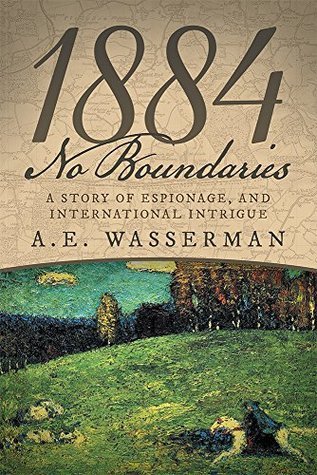 Love, murder, sex, and terrorism swirl within a collapsed world economy.
Love, murder, sex, and terrorism swirl within a collapsed world economy.No, it’s not today.
It’s London, 1884.
Recently married Langsford, born of wealth and privilege, is bound by the restrictions of Victorian society. Dynamite has been invented, but the term “homosexuality” has not and men can be arrested for either.
Langsford accompanies his visiting friend, HEINRICH, eighteen, who innocently flirts with young ANNA at London’s Leadenhall Market.
What should be the end of the story becomes the beginning, for Heinrich falls in love with her, never part of the plan. Instead it becomes the catalyst for everything that follows when he flees Germany to return to her. Events unfold that expose terrorists, espionage and international intrigue.
Langsford walks a fine line as he crosses boundaries he never imagined, rubbing elbows with spies, killers and would-be assassins to save his friend, stop an assassination, and prevent a war.
“Wasserman’s writing is atmospherically rich. Very strongly recommended.” – Historical Novel Society, London, critical review of 1884 No Boundaries
Amazon | Barnes & Noble
1886 Ties That Bind: A Story of Politics, Graft, and Greed
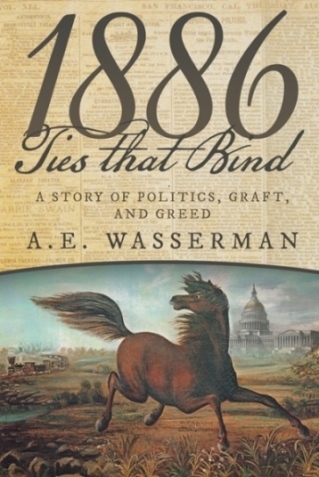
It is 1886 as Englishman Lord Langsford travels by train to San Francisco. Newly widowed, Langsford is desperate to escape his grief, demons, and life in England. As Langsford completes the last leg of his transcontinental journey, his life unexpectedly changes once again when he crosses paths with Miss Sally Baxter, a beautiful rancher who packs a pistol in her purse.
Sally has made it her mission to find the men who robbed a train and killed her brother. Unfortunately, no one—not even the owners of the Southern Pacific Railroad—seem to care. Unable to resist her pleas, Langsford offers to help Sally and soon becomes entangled in a web of politics, corruption, and greed. As murder, threats, and attacks ensue that endanger both Sally and Langsford, influential men in both California and Washington, D.C. jockey for positions of power. Langsford, who finds himself oddly attracted to Sally, now must sort through criminals and politicians alike to discover the truth behind her brother’s death and prevent his own murder.
“The author has woven a complex net of intrigue and background to the murder that makes the entire book so much more than just a mystery. As the title appropriately states, this deals with issues of politics, corruption and greed in a very accomplished way. One of the best books I’ve read in a long time. Highly recommended.” – Christoph Fischer, UK Reviewer Discovering Diamonds
Amazon | Barnes and Noble
1885: Crossingsby
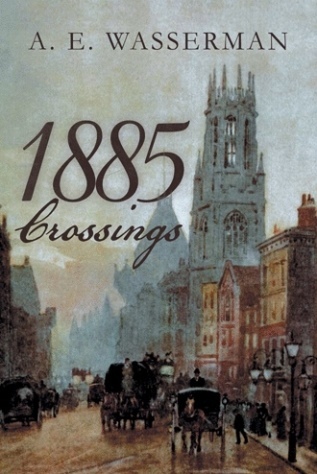 Anna’s hand holding the letter trembled as her vision rocked, going in and out of focus. She felt as though she was falling backward and at the same time rolling forward, expecting to land face first on the floor. She put her hand on the table to brace herself. She no longer heard the song birds in the buckeye tree outside the window, or the hoof beats on the cobblestones passing the front door, or any sound at all.
Anna’s hand holding the letter trembled as her vision rocked, going in and out of focus. She felt as though she was falling backward and at the same time rolling forward, expecting to land face first on the floor. She put her hand on the table to brace herself. She no longer heard the song birds in the buckeye tree outside the window, or the hoof beats on the cobblestones passing the front door, or any sound at all.The world around her ceased to exist—only the paper with Henry’s written words: his own account of what happened during the past year.The entire time, she’d known he wasn’t telling her everything—but this—she could never have imagined any of it. The hard fact was, Henry will never escape the truth.
“1885 Crossings gives us another opportunity to return to the world of Henry, Anna, and Langsford. A.E. Wasserman’s writing is beautifully done—tense and uncomfortable. The ending gave me a chill.” -Chuck Sambuchino, Bestselling Author
Amazon | Barnes & Noble
GiveawayDuring the Book Blast we will be giving away a $25 Amazon Gift Card! To enter, please enter here.
Giveaway Rules
• Giveaway ends at 11:59pm EST on January 12th. You must be 18 or older to enter.
• Giveaway is open INTERNATIONALLY.
•Only one entry per household.
•All giveaway entrants agree to be honest and not cheat the systems; any suspect of fraud is decided upon by blog/site owner and the sponsor, and entrants may be disqualified at our discretion.
•Winner has 48 hours to claim prize or new winner is chosen.
About the Author
 The daughter of a newspaperman, A.E. Wasserman grew up in a household filled with books and stories. At age 14, she wrote her first novella and never stopped writing.
The daughter of a newspaperman, A.E. Wasserman grew up in a household filled with books and stories. At age 14, she wrote her first novella and never stopped writing.She is the author of a new mystery/thrillers series, the first of which takes place in London: 1884 No Boundaries, A Story of Espionage and International Intrigue. The second in the Langsford Series, 1886 Ties That Bind, A Story of Politics, Graft and Greed, has just been released.
Her work, critically acclaimed as “richly atmospheric,” is being noticed by readers and critics alike, and has garnered international attention, not only in the U.S., but Europe and the U.K. as well. She recently received top honors from Writer’s Digest for her work.
After graduating from The Ohio State University, she lived in London, then San Francisco. Currently she resides in Southern California with her family and her muse, a Border Collie named Topper.
For more information, please Visit the author’s web site at www.aewasserman.com. You can also connect with her on Facebookand Twitter.
Published on January 05, 2018 23:00
The Coffee Pot Book Club
The Coffee Pot Book Club (formally Myths, Legends, Books, and Coffee Pots) was founded in 2015. Our goal was to create a platform that would help Historical Fiction, Historical Romance and Historical
The Coffee Pot Book Club (formally Myths, Legends, Books, and Coffee Pots) was founded in 2015. Our goal was to create a platform that would help Historical Fiction, Historical Romance and Historical Fantasy authors promote their books and find that sometimes elusive audience. The Coffee Pot Book Club soon became the place for readers to meet new authors (both traditionally published and independently) and discover their fabulous books.
...more
...more
- Mary Anne Yarde's profile
- 159 followers



